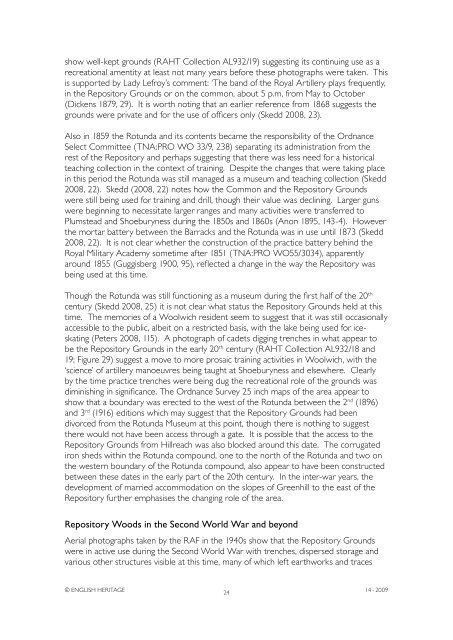REPOSITORy wOODS, wOOlwICH, gREATER ... - English Heritage
REPOSITORy wOODS, wOOlwICH, gREATER ... - English Heritage
REPOSITORy wOODS, wOOlwICH, gREATER ... - English Heritage
- No tags were found...
Create successful ePaper yourself
Turn your PDF publications into a flip-book with our unique Google optimized e-Paper software.
show well-kept grounds (RAHT Collection AL932/19) suggesting its continuing use as arecreational amentity at least not many years before these photographs were taken. Thisis supported by Lady Lefroy’s comment: ‘The band of the Royal Artillery plays frequently,in the Repository Grounds or on the common, about 5 p.m, from May to October(Dickens 1879, 29). It is worth noting that an earlier reference from 1868 suggests thegrounds were private and for the use of officers only (Skedd 2008, 23).Also in 1859 the Rotunda and its contents became the responsibility of the OrdnanceSelect Committee (TNA:PRO WO 33/9, 238) separating its administration from therest of the Repository and perhaps suggesting that there was less need for a historicalteaching collection in the context of training. Despite the changes that were taking placein this period the Rotunda was still managed as a museum and teaching collection (Skedd2008, 22). Skedd (2008, 22) notes how the Common and the Repository Groundswere still being used for training and drill, though their value was declining. Larger gunswere beginning to necessitate larger ranges and many activities were transferred toPlumstead and Shoeburyness during the 1850s and 1860s (Anon 1895, 143-4). Howeverthe mortar battery between the Barracks and the Rotunda was in use until 1873 (Skedd2008, 22). It is not clear whether the construction of the practice battery behind theRoyal Military Academy sometime after 1851 (TNA:PRO WO55/3034), apparentlyaround 1855 (Guggisberg 1900, 95), reflected a change in the way the Repository wasbeing used at this time.Though the Rotunda was still functioning as a museum during the first half of the 20 thcentury (Skedd 2008, 25) it is not clear what status the Repository Grounds held at thistime. The memories of a Woolwich resident seem to suggest that it was still occasionallyaccessible to the public, albeit on a restricted basis, with the lake being used for iceskating(Peters 2008, 115). A photograph of cadets digging trenches in what appear tobe the Repository Grounds in the early 20 th century (RAHT Collection AL932/18 and19; Figure 29) suggest a move to more prosaic training activities in Woolwich, with the‘science’ of artillery manoeuvres being taught at Shoeburyness and elsewhere. Clearlyby the time practice trenches were being dug the recreational role of the grounds wasdiminishing in significance. The Ordnance Survey 25 inch maps of the area appear toshow that a boundary was erected to the west of the Rotunda between the 2 nd (1896)and 3 rd (1916) editions which may suggest that the Repository Grounds had beendivorced from the Rotunda Museum at this point, though there is nothing to suggestthere would not have been access through a gate. It is possible that the access to theRepository Grounds from Hillreach was also blocked around this date. The corrugatediron sheds within the Rotunda compound, one to the north of the Rotunda and two onthe western boundary of the Rotunda compound, also appear to have been constructedbetween these dates in the early part of the 20th century. In the inter-war years, thedevelopment of married accommodation on the slopes of Greenhill to the east of theRepository further emphasises the changing role of the area.Repository Woods in the Second World War and beyondAerial photographs taken by the RAF in the 1940s show that the Repository Groundswere in active use during the Second World War with trenches, dispersed storage andvarious other structures visible at this time, many of which left earthworks and traces© ENGLISH HERITAGE2414 - 2009
















